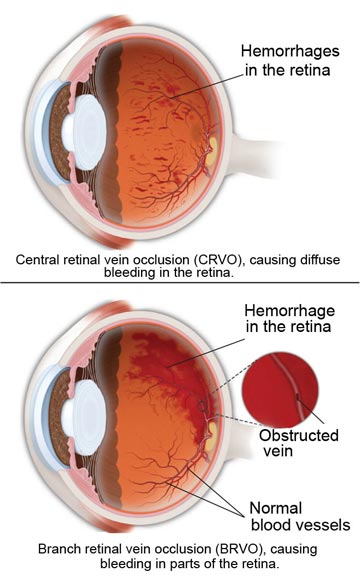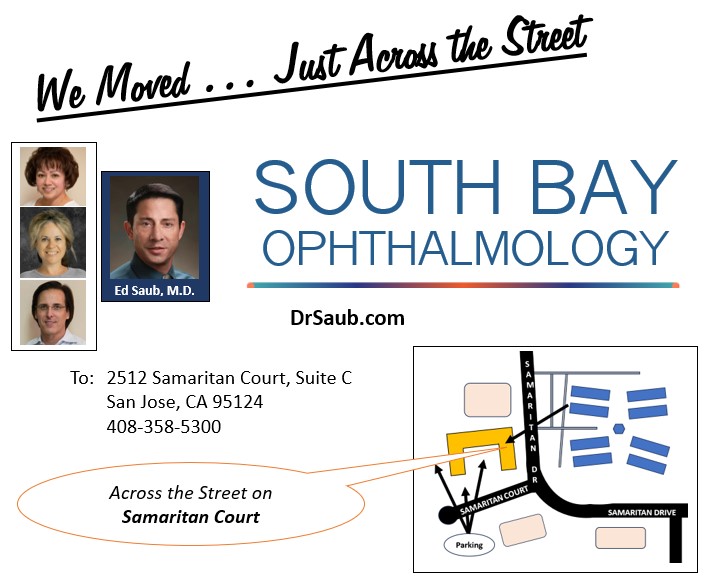Retinal Vein Occlusion
A retinal vein occlusion occurs when a vein in the eye’s retina is blocked.
The retina is the layer of light-sensing cells lining the back of your eye. It converts light rays into signals, which are sent through the optic nerve to your brain where they are recognized as images.
A blocked vein damages the blood vessels of the retina. Hemorrhages (bleeding) and leakage of fluid occurs from the areas of blocked blood vessels.
There are two different types of retinal vein occlusion:
Central retinal vein occlusion (CRVO): when the main vein of the eye (located at the optic nerve) becomes blocked
Branch retinal vein occlusion (BRVO): when one of the smaller branches of vessels attached to the main vein becomes blocked
 Who is at risk for a retinal vein occlusion?
Who is at risk for a retinal vein occlusion?
Certain illnesses increase your risk for developing retinal vein occlusion, including:
- Diabetes
- Glaucoma
- High blood pressure
- Age-related vascular (blood vessel) disease
- Blood disorders
- If a branch retinal vein occlusion occurs in one eye, there is an increased chance (about 10 percent) that a branch or central vein occlusion will occur in the other eye in the future.
What are the complications and symptoms of retinal vein occlusion?
Macular edema. If blood and fluid leak into the central part of the retina called the macula, swelling of the macula occurs (called macular edema). The macula is the part of your retina responsible for your fine detail vision. It is what allows you to read small print, thread a needle, and read street signs. Macular edema causes blurred vision, decreased vision or both.
Abnormal blood vessel growth (neovascularization). Retinal vein occlusion can cause abnormal vessels to begin to grow on the retina. These new vessels are very fragile and may bleed or leak fluid into the vitreous — the gel-like substance that fills the center of the eye. Small spots or clouds in your field of vision called floaters can appear. In more advanced cases of neovascularization, the abnormal blood vessels may actually cause the retina to detach from the back of the eye.
Pain in the eye. In severe cases of CRVO, a blocked vein causes abnormal blood vessel growth on the iris and drainage channels in the front of the eye, leading to painful pressure in the eye (neovascular glaucoma).
If complications from retinal vein occlusion are not treated, irreversible blindness may occur.
How is retinal vein occlusion detected?
Your ophthalmologist (Eye M.D.) detects retinal vein occlusions by examining the retina with an instrument called an ophthalmoscope. The Eye M.D. may also perform fluorescein angiography, a procedure that takes special photographs of the eye, in order to further investigate the blood vessels in your eye.
How is retinal vein occlusion treated?
There is no known cure for retinal vein occlusion, though in some cases intraocular injections, laser surgery, or an operation may be used to reduce the macular edema and stabilize or improve vision. In severe CRVO, laser surgery is used to prevent or treat the abnormal blood vessel growth that can lead to glaucoma or bleeding. In some cases surgery may be necessary.
You may be able to prevent retinal vein occlusion from occurring again by properly managing any health conditions that contribute to this eye problem (such as diabetes, glaucoma or high blood pressure).
Branch Retinal Vein Occlusion
Branch Retinal Vein Occlusion Injections
Central Retinal Vein Occlusion
Central Retinal Vein Occlusion Injection
- Anatomy of the Eye
- Botox
- Cataracts
- Diabetes and the Eye
- Diabetic Retinopathy – What is it and how is it detected?
- Treatment for Diabetic Retinopathy
- Non-Proliferative Diabetic Retinopathy (NPDR) – Video
- Proliferative Diabetic Retinopathy (PDR) – Video
- Cystoid Macular Edema
- Vitreous Hemorrhage – Bleeding from diabetes (Video)
- Vitrectomy Surgery for Vitreous Hemorrhage (Video)
- Macular Edema
- Laser Procedures for Macular Edema (Video)
- Laser for Proliferative Diabetic Retinopathy – PDR (Video)
- How the Eye Sees (Video)
- Dilating Eye Drops
- Dry Eyes and Tearing
- Eye Lid Problems
- A Word About Eyelid Problems
- Bells Palsy
- Blepharitis
- Blepharoptosis – Droopy Eyelids (Video)
- Dermatochalasis – excessive upper eyelid skin (Video)
- Ectropion – Sagging Lower Eyelids (Video)
- Entropion – Inward Turning Eyelids (Video)
- How to Apply Warm Compresses
- Ocular Rosacea
- Removing Eyelid Lesions
- Styes and Chalazion
- Twitches or Spasms
- Floaters and Flashes
- Glaucoma
- Selective Laser Trabeculoplasty (SLT) for Glaucoma
- Glaucoma: What is it and how is it detected?
- Optical Coherence Tomography OCT – Retina & Optic Nerve Scan
- Treatment for Glaucoma
- Retinal Nerve Fibers and Glaucoma (Video)
- Open Angle Glaucoma (Video)
- Closed Angle Glaucoma (Video)
- Visual Field Test for Glaucoma
- Glaucoma and Blind Spots (Video)
- Treatment for Glaucoma with Laser Iridotomy (Video)
- Laser Treatment for Glaucoma with ALT and SLT (Video)
- Surgical Treatment for Glaucoma with Trabeculectomy (Video)
- Surgical Treatment of Glaucoma with Seton (Video)
- Keeping Eyes Healthy
- Laser Vision Correction
- Latisse for Eyelashes
- Macular Degeneration
- Macular Degeneration – What is it and how is it detected?
- Treatment for Macular Degeneration
- Dry Macular Degeneration (Video)
- Wet Macular Degeneration (Video)
- Treatment of Macular Degeneration with Supplements
- Treatment of Wet Macular Degeneration with Anti-VEGF Injections
- Amsler Grid – A home test for Macular Degeneration (Video)
- Living with Vision Loss
- How the Eye Works – The Macula (Video)
- Other Eye Conditions
- Central Serous Retinopathy
- Lattice Degeneration of the Retina
- A Word About Other Eye Conditions
- Amblyopia
- Carotid Artery Disease and the Eye
- Fuch’s Corneal Dystrophy
- Herpes Simplex and the Eye
- Herpes Zoster (Shingles) and the Eye
- Ischemic Optic Neuropathy
- Keratoconus
- Macular Hole
- Macular Pucker
- Microvascular Cranial Nerve Palsy
- Migraine and the Eye
- Optic Neuritis
- Pseudotumor Cerebri
- Retinal Vein Occlusion
- Retinitis Pigmentosa
- Retinopathy of Prematurity
- Strabismus
- Thyroid Disorders and the Eye
- Uveitis
- Vitreomacular Adhesions / Vitreomacular Traction Syndrome
- Red Eye
- Refractive Errors
- Retinal Tears and Detachments
Disclaimer
This Patient Education Center is provided for informational and educational purposes only. It is NOT intended to provide, nor should you use it for, instruction on medical diagnosis or treatment, and it does not provide medical advice. The information contained in the Patient Education Center is compiled from a variety of sources. It does NOT cover all medical problems, eye diseases, eye conditions, ailments or treatments.
You should NOT rely on this information to determine a diagnosis or course of treatment. The information should NOT be used in place of an individual consultation, examination, visit or call with your physician or other qualified health care provider. You should never disregard the advice of your physician or other qualified health care provider because of any information you read on this site or any web sites you visit as a result of this site.
Promptly consult your physician or other qualified health provider if you have any health care questions or concerns and before you begin or alter any treatment plan. No doctor-patient relationship is established by your use of this site.


